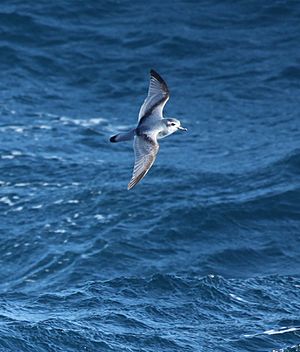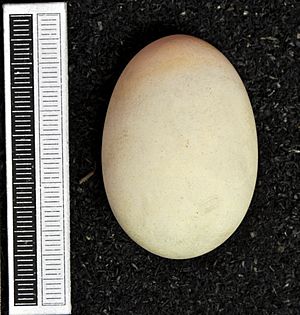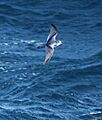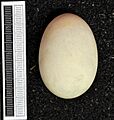Antarctic prion facts for kids
Quick facts for kids Antarctic prion |
|
|---|---|
 |
|
| Flying over the South Atlantic Ocean between the Falkland Islands and South Georgia | |
| Conservation status | |
| Scientific classification | |
| Genus: |
Pachyptila
|
| Species: |
desolata
|
| Subspecies | |
|
P. desolata altera |
|
| Synonyms | |
|
Prion desolatus (Gmelin, 1789) |
|
The Antarctic prion (Pachyptila desolata) is a fascinating seabird. It's also called the dove prion. In the Māori language, it's known as totorore. This bird is the biggest of all the prions. Prions are a group of small petrels that live in the Southern Ocean.
Contents
About the Antarctic Prion
The Antarctic prion belongs to a group of birds called Pachyptila. This group, along with the blue petrel, forms what we call the prions. These birds are part of the Procellariidae family. This family includes many types of seabirds.
Prions are known for eating tiny ocean creatures called zooplankton. They have some special features. For example, they have unique nasal passages. These are like tubes on top of their upper beak.
Their beaks are also special. They are made of seven to nine tough plates. These birds can make a special stomach oil. This oil is stored in a part of their stomach. They can spray this oil out of their mouths. It helps them defend against predators. It's also a rich food source for their chicks. Adult birds can use it for energy during long flights.
Another cool feature is their salt gland. This gland is above their nose. It helps them get rid of extra salt from their bodies. This is important because they drink a lot of ocean water. The gland removes the salt and releases it from their nose.
Types of Antarctic Prions
There are three different types, or subspecies, of the Antarctic prion:
- Pachyptila desolata desolata: This type breeds on the Crozet Islands, Kerguelen Islands, and Macquarie Island.
- Pachyptila desolata altera: This type breeds on Heard Island and the Auckland Islands.
- Pachyptila desolata banksi: This type breeds in the Scotia Arc. You can find them on South Georgia, the South Sandwich Islands, and Scott Island.
What's in a Name?
The name Pachyptila comes from Greek words. Pakhus means "thick" or "stout". Ptilon means "a feather". So, it means "thick feather".
The word desolatus is Latin. It means "forsaken" or "desolate". This name refers to the lonely, icy Antarctic region where these birds live.
The word prion also comes from Greek. It comes from priōn, meaning "a saw". This refers to the saw-like edges on the bird's bill. These edges help them filter food.
Appearance of the Antarctic Prion
The Antarctic prion is a medium-sized bird. Its wingspan is about 17 to 20 centimeters (6.7 to 7.9 inches). Its body length is around 28 centimeters (11 inches).
Like all prions, it has a white belly. Its upper parts are blue-grey. It has a dark "M" shape across its back and wingtips. It also has a white line above its eye. Its bill is blue-grey, and its feet are blue.
Its tail is grey and wedge-shaped. It has a black tip. The larger feathers on its wings are almost black.
Behavior and Life
Feeding Habits
The Antarctic prion mainly eats tiny sea creatures called zooplankton. It gets its food by filtering water through its upper bill. The saw-like edges on its bill help it strain out these small organisms.
Reproduction and Nesting
Antarctic prions nest in large groups called colonies. They prefer to build their nests on islands in the Southern Ocean. Both the male and female birds help build the nest. They also take turns sitting on the single egg. After the chick hatches, both parents work together to raise it.
Where They Live
These birds breed in colonies on many islands. These include the Auckland Islands, Heard Island, Macquarie Island, Scott Island, South Georgia and the South Sandwich Islands, the South Orkney Islands, South Shetland Islands, Crozet Islands, and the Kerguelen Islands.
When they are not breeding, they travel across the vast southern oceans.
Conservation Status
The Antarctic prion lives across a very large area. This area is about 76,600,000 square kilometers (29,600,000 square miles). Scientists estimate that there are about 50 million adult birds. Because of their large numbers and wide range, they are not currently considered endangered.
Images for kids
See also
In Spanish: Pato petrel antártico para niños





